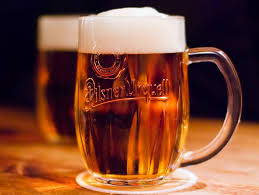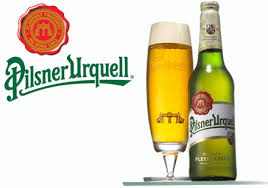Editor’s Note: This is an excerpt from author John Hailman’s book ‘The Search for Good Wine’ which will be available for purchase October 2014 from the University of Mississippi Press. This particular chapter was written on September 16,1990.
The weather in August is too hot for words – or wine. At such times, even wine columnists turn to beer. My favorite for many years has been the great Pilsner Urquell from Bohemia, now known as Czechoslovakia. It was my first choice at a blind tasting of 50 top beers at The Washington Post when i wrote the wine column there in 1974, and it has been ever since. For the record, the overall favorite of the dozen tasters was Beck’s from Germany, a tad lighter, drier, and more “modern”.
 f you don’t think the Czechs make fine beer, check it out with the Germans – East and West – who import more Pilsner Urquell than any other beer. I also read somewhere, and believe it, that for a German restaurant to get four stars in a local guide it as to serve Pilsner Urquell from the cask. May I see the beer list, please?
f you don’t think the Czechs make fine beer, check it out with the Germans – East and West – who import more Pilsner Urquell than any other beer. I also read somewhere, and believe it, that for a German restaurant to get four stars in a local guide it as to serve Pilsner Urquell from the cask. May I see the beer list, please?
Even the name they use on U.S. bottling is actually German, perhaps because the Czech name is even harder to pronounce. Urquell, pronounce “irk-qell”, means “original source”, referring to the town of Pilsen as the place where the method of making clear, light-colored beer was first discovered in the 1840s.
What is so special about this beer? First of all, it goes down more like wine than any other beer I’ve tasted. They don’t call it the chardonnay of beers for nothing. Like fine wines, it is made in oak vats, not stainless steel, and aged or “lagered” in oak barrels in cool, limestone cellars. Like Coors, it is made from special water, although not mountain springs, but from artisan wells. Its hops are the unanimous choice as best in the world. Its barley has only two rows of grains, not six, sort of like the best clones of the best wine grapes.
One thing I don’t enjoy is people making too much of a fuss about describing the taste of beer as if they were tasting wine. They are not the same. Nevertheless, if you need a little of that sort of thing, the Gourmet Guide to Beer describes Urquell this way: “amber-golden color with a rich, expansive, fruity nose, complex on the palate, full-bodied for a pale lager, with thrilling balance and a dry, woody, hoppy finish.” There you have one view. I would have called it subtle and delicious.
The Czech’s on its way
Pilsen was charted in 1291 by the famed “good King Wenceslas”, who really existed along with one other brewing town, Budweis, where the original you-know-what came from. With the fall of communism, talks are under way for U.S. Budweiser to drop its con-compete agreement with the Czechs so we can drink their version here also.
 Guinness Imports already has raised its Urquell quota for the U.S., where we drank nearly a half-million gallons of it last year alone. They made 40 million gallons, one-third for export, so they will be able to handle our needs.
Guinness Imports already has raised its Urquell quota for the U.S., where we drank nearly a half-million gallons of it last year alone. They made 40 million gallons, one-third for export, so they will be able to handle our needs.
At around a dollar a 12-ounce bottle (it doesn’t come in cans), Pilsner Urquell is one of the last affordable luxuries. The glass I just finished made me think of Prague, perhaps the most intriguing of European cities after Paris. There is nothing like a beer cellar in Prague for nostalgia.
The taste of Urquell is old-fashioned, and for my money that is good. The Czechs called it “liquid bread”. Who wants beer whose self-proclaimed best quality is that it has no aftertaste? Hold the light beer and pass me a rich, full, mellow, golden, lingering … well, you get the idea.
Michael Jackson, the one with two gloves, wrote the best seller of beer books called “New World Guide”. He theorized that the Czechs make their beer so wine-like because they live on that invisible line across Europe between the warm, wine-drinking countries of the south and the cold, beer-drinking countries of the north. His book reproduces labels of 23 different recommended Czech beers, including “Dragon” and “Golden Horse”. Until they arrive my choice is Pilsner Urquell.
 John Hailman of Oxford is a regular contributor to HottyToddy.com on two subjects: Law and Wine. Now retired from both his “day job” as a federal prosecutor in Oxford after 33 years and his “night job” of 25 years as a nationally syndicated daily columnist in more than 100 daily papers on wine, food and travel for Gannett News Service and the Washington Post, Hailman will cover both topics under the titles of The Legal Eagle and Wine Tips of the Week. HottyToddy.com will also run periodic excerpts from Hailman’s upcoming book of humorous legal stories, From Midnight to Guntown: True Crime Stories From A Federal Prosecutor in Mississippi. Hailman now teaches Federal Trial Practice and Law and Literature at the University of Mississippi.
John Hailman of Oxford is a regular contributor to HottyToddy.com on two subjects: Law and Wine. Now retired from both his “day job” as a federal prosecutor in Oxford after 33 years and his “night job” of 25 years as a nationally syndicated daily columnist in more than 100 daily papers on wine, food and travel for Gannett News Service and the Washington Post, Hailman will cover both topics under the titles of The Legal Eagle and Wine Tips of the Week. HottyToddy.com will also run periodic excerpts from Hailman’s upcoming book of humorous legal stories, From Midnight to Guntown: True Crime Stories From A Federal Prosecutor in Mississippi. Hailman now teaches Federal Trial Practice and Law and Literature at the University of Mississippi.

